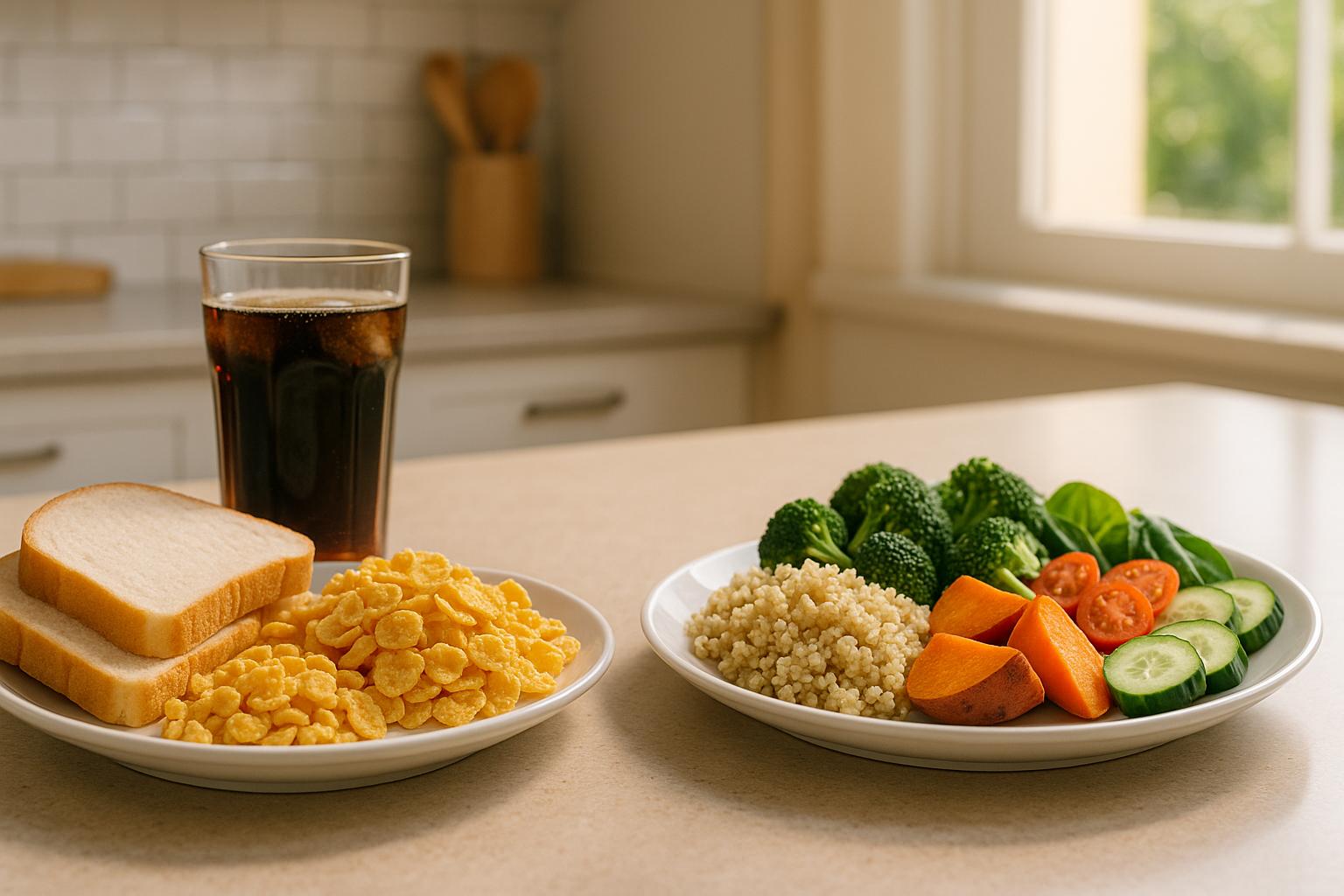Which is better: Variable Resistance Training (VRT) or Traditional Resistance Training (TRT)? It depends on your goals. Here’s a quick breakdown:
- VRT adjusts resistance dynamically, matching your strength at different points in a movement. Tools like bands and chains are often used, making it great for reducing joint stress, improving power, and overcoming sticking points.
- TRT uses a constant load throughout the exercise. It’s ideal for building foundational strength and muscle mass, with simpler setups using free weights or machines.
Quick Comparison
| Feature | Variable Resistance Training (VRT) | Traditional Resistance Training (TRT) |
|---|---|---|
| Resistance Profile | Changes throughout the movement | Stays constant |
| Equipment | Bands, chains, cam-based machines | Free weights, standard machines |
| Sticking Points | Reduces sticking points | Limited by weakest point |
| Muscle Activation | Higher across the full range | Limited by weakest range of motion |
| Cost | Bands: $5–$30; Machines: Expensive | Free weights: $100–$300; Full setup: $800–$1,500 |
| Portability | High (bands); Low (machines) | Medium (free weights); Low (machines) |
| Best For | Explosive strength, reducing joint stress, rehab | Foundational strength, muscle mass, beginners |
Both methods are effective for building strength and muscle. A hybrid approach combining VRT and TRT can help maximize results while minimizing weaknesses. Choose based on your goals, equipment access, and budget.
Variable vs. Constant Resistance Training: What’s the difference?
How Each Resistance Method Works
Building on our overview, let's take a closer look at how each method operates.
Variable Resistance Training
Variable resistance training adjusts the resistance throughout an exercise to align with your body's natural strength curve. Unlike lifting a fixed weight, this approach modifies the load dynamically. For instance, when performing a bench press, the resistance decreases during weaker phases of the movement and increases during stronger phases, ensuring better muscle activation.
This technique often uses tools like resistance bands, chains, or specialized machines. Strength and conditioning expert Christian Bosse explains the difference between these tools:
"The resistance provided by chains is linear, whilst bands provide the resistance exponentially."
By tailoring the load to your strength at different points in the exercise, variable resistance training not only enhances muscle engagement but can also improve strength gains. Additionally, it may lower the risk of injury, making it a valuable option for rehabilitation.
Traditional Resistance Training
Traditional resistance training involves lifting a constant load throughout the entire movement. This method relies on tools like free weights, barbells, and weight machines, and it follows the principle of progressive overload - gradually increasing the resistance to challenge muscles and encourage growth.
However, biomechanics reveal a limitation: during traditional exercises, force output in the mid-range of the motion can drop to just 25–33% of your maximum strength capacity. A typical routine might include three weekly sessions, with each session featuring three sets of nine repetitions at 75% of your one-repetition maximum. Each phase of the movement - both lifting (concentric) and lowering (eccentric) - usually lasts about two seconds, with two-minute rest periods between sets. Because the resistance remains constant, certain parts of the movement may not fully challenge the muscles, leading to potential inefficiencies at "sticking points."
Despite these limitations, traditional resistance training remains a proven method for building strength and muscle mass, provided it incorporates proper technique and consistent application of progressive overload.
Note: This article is for informational purposes only and does not constitute medical advice. Consult a healthcare professional before beginning any new fitness or wellness program.
Equipment for Variable vs. Traditional Resistance
The type of equipment you use directly influences your workout technique and results. Each approach - variable or traditional resistance - utilizes different tools to apply resistance, and understanding these tools is crucial for tailoring your training effectively.
Variable Resistance Equipment
Variable resistance tools, like resistance bands, weightlifting chains, and cam-based machines, adjust the load dynamically to match your strength curve throughout the movement.
Resistance bands are lightweight, portable, and budget-friendly. They’re great for those on the go, but for serious strength and muscle-building, heavier bands are necessary to provide enough challenge.
Weightlifting chains add resistance as you lift. As more chain links rise off the ground, the load increases progressively. This makes them ideal for movements like squats and bench presses, though they’re best suited for vertical exercises.
Cam-based machines use specially designed wheels (cams) to vary resistance during an exercise. These machines, common in commercial gyms, offer smooth and controlled resistance. However, their fixed movement paths may not engage stabilizing muscles as effectively as bands or chains.
One major benefit of variable resistance equipment is its ability to align with your body’s natural strength curve, maximizing muscle activation at your strongest points during the movement.
Traditional Resistance Equipment
Traditional resistance tools provide a consistent load throughout the exercise. This category includes free weights, standard cable machines, and fixed-resistance gym machines, each offering unique advantages.
Free weights - like barbells, dumbbells, and kettlebells - are a cornerstone of strength training. They allow for unrestricted movement across all planes and engage stabilizing muscles effectively.
Standard cable machines use pulleys and weight stacks to deliver consistent resistance and support a wide variety of exercises.
Fixed-resistance gym machines come in two forms: selectorized machines with adjustable weight stacks and plate-loaded machines. Selectorized machines are beginner-friendly, offering easy weight adjustments and controlled movements. Plate-loaded machines, while requiring manual weight changes, can handle heavier loads and operate more smoothly.
Traditional resistance equipment excels at progressive overload, the gradual increase in resistance that drives strength and muscle gains. Its consistent load simplifies tracking progress and fine-tuning training intensity. However, because the resistance stays the same throughout the movement, certain phases may not challenge your muscles as much, potentially leading to sticking points.
Both variable and traditional resistance equipment have a place in a balanced training routine. Many fitness enthusiasts combine free weights with resistance bands to reap the benefits of both while minimizing their individual drawbacks.
This article is for informational purposes only and is not intended as medical advice. Please consult a healthcare professional before starting any new fitness or wellness routine.
Training Results: Comparing the Outcomes
Building on the mechanics discussed earlier, let’s dive into how each training method translates into results. Both variable resistance training (VRT) and traditional resistance training (TRT) can improve strength, but each comes with its own set of benefits depending on your fitness goals.
Variable Resistance Training Results
Variable resistance training adjusts the load throughout the movement, aligning with your muscles' changing ability to produce force at different points. This approach ensures greater muscle activation across the entire range of motion.
One of the standout benefits of VRT is its ability to reduce deceleration phases during exercises. For instance, during an 80% 1‑RM bench press, research shows that 52% of the upward movement involves deceleration. By minimizing this, VRT allows for higher mean power per repetition, especially when movements are performed with maximum effort.
Studies also suggest that VRT can be particularly effective depending on the individual’s training level. For trained individuals lifting loads above 80% of their 1‑RM, VRT tends to yield better strength gains. On the other hand, untrained individuals seem to benefit more from lighter loads (below 80% of 1‑RM). However, factors like body type and baseline strength can influence how effective VRT is, especially for exercises requiring significant force production, where traditional methods may sometimes be a better fit.
Traditional Resistance Training Results
Traditional resistance training, with its constant load throughout the movement, is a tried-and-true method for building foundational strength. This consistency makes it particularly effective for applying progressive overload.
A meta-analysis of 17 studies involving 491 participants found no significant differences between VRT and TRT when it comes to improving maximal muscle strength in both upper and lower body exercises (p = 0.46 for lower body, p = 0.14 for upper body). TRT is especially effective for building strength and muscle mass through structured programs involving progressive overload and high-repetition schemes. In some cases, TRT even outperformed VRT for lower body strength when more repetitions were included.
When it comes to muscle growth (hypertrophy), a review of 12 studies found similar improvements between VRT and TRT over short- to medium-term periods, with no significant differences between the two methods. The predictability of TRT makes it easier to track progress, plan workouts, and maintain proper technique, which is particularly helpful for beginners or those seeking a straightforward approach.
Ultimately, the best choice depends on your goals, experience, and what you want to achieve. Many effective training programs combine elements of both VRT and TRT to maximize results.
This article is for informational purposes only and is not intended as medical advice. Please consult a healthcare professional before starting any new fitness or wellness routine.
Comparison Table: Key Differences at a Glance
Here’s a quick look at how Variable Resistance Training (VRT) stacks up against Traditional Resistance Training (TRT):
| Feature | Variable Resistance Training | Traditional Resistance Training |
|---|---|---|
| Resistance Profile | Adjusts throughout the movement, aligning with muscle force potential | Maintains the same external load through the entire range of motion |
| Load Distribution | Provides more resistance in stronger positions and less in weaker ones | Keeps resistance constant, regardless of leverage |
| Sticking Point | Reduces sticking points by balancing resistance evenly | Performance is limited by the weakest point in the movement |
| Equipment Types | Uses tools like elastic bands, chains, cam-based machines, and pneumatic machines | Relies on free weights (barbells, dumbbells) and standard weight machines |
| Resistance Curve | Resistance increases exponentially (bands) or linearly (chains) | Resistance remains flat and consistent |
| Deceleration Phase | Features a shorter deceleration phase compared to TRT | Up to 40–52% of the movement involves deceleration at higher intensities |
| Muscle Activation | Promotes higher activation across the full range of motion | Activation is limited by the weakest point in the motion |
| Optimal Load (Trained) | Best results with ≥80% of 1RM for strength gains | Follows standard progressive overload principles |
| Optimal Load (Untrained) | Effective with loads <80% of 1RM | Follows traditional beginner programming guidelines |
| Joint Stress | Reduces stress on joints when muscles are less engaged | Applies consistent joint loading throughout the motion |
| Setup Complexity | May require extra setup, such as bands or chains | Simple setup with standard weights |
| Cost Accessibility | Bands are budget-friendly; specialized machines can be pricey | Options range from low-cost to high-end |
| Portability | Bands are easy to carry; chains and machines are less portable | Free weights are somewhat portable; machines are stationary |
These details can help you decide which method aligns with your fitness goals. Up next, we’ll explore practical tips for U.S. fitness enthusiasts to incorporate these techniques into their routines.
This article is for informational purposes only and is not intended as medical advice. Always consult a healthcare professional before starting a new fitness or wellness program.
Practical Considerations for U.S. Fitness Enthusiasts
When deciding between variable resistance training (VRT) and traditional resistance training, factors like cost, space, and performance outcomes play a big role. Both approaches cater to various budgets and fitness levels, making it easier to find an option that fits your needs. Here's a closer look at equipment costs and space requirements for each.
Traditional gyms across the U.S. are typically stocked with free weights and standard weight machines, making them accessible for most fitness enthusiasts. If you're setting up a home gym, a basic dumbbell set can cost between $100 and $300, while Olympic barbells are priced similarly, starting at $100 and going beyond $300. A complete home gym setup - including dumbbells, a barbell, weight plates, and a bench - usually ranges from $800 to $1,500.
On the other hand, VRT offers a more budget-friendly alternative through resistance bands. Basic bands are available for as little as $5 and go up to $30 each. Lifeline resistance cables are priced between $5.99 and $18.99, while complete Resistance Trainer Kits range from $83.99 to $146.99. For those looking for advanced options, the LIT AXIS smart resistance bands are currently $99, a drop from their original price of $199.
When it comes to space, resistance bands have a clear advantage. They are compact and easy to store, making them ideal for small spaces. In contrast, free weights and traditional equipment require dedicated storage areas. While free weights remain a staple in most gyms, specialized variable resistance machines are typically found in niche fitness centers or designed for home use .
VRT also has specific benefits, such as aiding in post-operative recovery. If you're shopping for equipment, February is a great time to find deals, as demand tends to drop after the New Year's resolution surge. Starting with basic equipment and gradually expanding your setup as your training progresses is a practical approach.
The American College of Sports Medicine emphasizes the importance of resistance training in any fitness regimen, highlighting its role in strengthening muscles, bones, and connective tissues. Ultimately, the best choice depends on your fitness goals, available space, and budget.
This article is for informational purposes only and is not intended as medical advice. Always consult a healthcare professional before beginning any new fitness or wellness routine.
Conclusion: Choosing the Right Method for Your Goals
When it comes to Variable Resistance Training (VRT) and Traditional Resistance Training (TRT), both have their strengths depending on your goals, experience level, and personal preferences. Research indicates that these methods are equally effective in building muscle strength and power in healthy adults.
For those focused on strength, experienced lifters often benefit from VRT when using loads of 80% or more of their one-rep max (1RM). On the other hand, beginners may achieve better outcomes by starting with lighter loads. That said, TRT remains an excellent option for building strength, particularly with heavier weights.
In terms of muscle growth, both approaches are effective, though VRT might promote a more uniform development across muscle groups. These advantages naturally translate into athletic performance gains as well.
VRT is especially beneficial for sports that demand explosive strength, as seen in studies showing improved punch performance. For activities where muscle mass is a key factor - like bodybuilding - VRT may offer unique advantages.
A hybrid approach, combining VRT and TRT, could be the best of both worlds. Research suggests that adding resistance bands to free weights produces greater improvements in power and force output compared to free weights alone. This combination allows you to target various points of the strength curve and can help prevent training plateaus.
Ultimately, the right choice depends on practical considerations like access to equipment and budget, alongside your specific goals. However, consistency and progressive overload are the true cornerstones of progress. Pick the method that aligns with your objectives and lifestyle, and stick with it.
This article is for informational purposes only and does not substitute for professional medical advice. Always consult a healthcare provider before beginning any new fitness or wellness program.
FAQs
Which is better for my fitness goals: Variable Resistance Training (VRT) or Traditional Resistance Training (TRT)?
Choosing Between Variable Resistance Training (VRT) and Traditional Resistance Training (TRT)
Your choice between Variable Resistance Training (VRT) and Traditional Resistance Training (TRT) really boils down to what you’re aiming to achieve and how you like to train.
VRT shines when it comes to maximizing muscle engagement across the entire range of motion. It’s particularly useful if your focus is on refining body composition or honing in on specific strength improvements. On the flip side, TRT is a go-to for those looking to build overall muscle strength and achieve muscle growth (hypertrophy). Its straightforward structure makes it a great pick for general fitness enthusiasts or anyone who enjoys a simpler workout setup.
Think about what you want to accomplish: if your goal is to target precise muscle activation and achieve specific outcomes, VRT might suit you better. But if you’re after a well-rounded, adaptable routine, TRT could be your best bet.
What are the benefits of using resistance bands or chains in variable resistance training compared to traditional gym equipment?
Using resistance bands or chains in variable resistance training brings unique advantages that traditional gym equipment often can't offer. These tools adjust resistance throughout the movement, keeping your muscles engaged at every stage. This approach helps boost muscle activation, build strength, and tackle those tricky "sticking points" - the toughest parts of a lift.
What’s more, resistance bands and chains allow you to achieve progressive overload without constantly piling on more weight. They’re also gentler on your joints, making them a safer option for building strength and power. Whether you're a beginner or an experienced lifter, these tools can be a game-changer in your workout routine.
Is variable resistance training equipment a better investment for a home gym than traditional weights?
Variable resistance training equipment, such as resistance bands or pneumatic systems, can range in price from $179 to $2,999, depending on the brand and complexity. In contrast, traditional resistance tools like free weights or machines typically cost between $500 and $5,000 for a complete setup.
While traditional weights might seem more affordable upfront, they often require more space and additional components to create a well-rounded workout environment. Variable resistance systems, however, tend to be more compact and versatile, making them a practical choice for smaller home gyms. The right option really comes down to your budget, available space, and fitness objectives.












